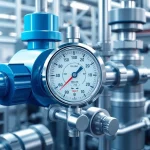
Introduction to Nitrogen Regulators
Nitrogen regulators are crucial components in various industrial and scientific applications, offering a means to control the pressure and flow of nitrogen gas from high-pressure cylinders. These devices ensure that gas is delivered at safe and precise pressures, which is critical for processes requiring specific gas concentrations and flow rates. Understanding the intricacies of nitrogen regulators can significantly improve operational efficiency and safety standards in environments that rely on this inert gas. For further reading on nitrogen regulators, consider exploring options available at nitrogen regulator websites.
What is a Nitrogen Regulator?
A nitrogen regulator is a device that reduces the pressure from a nitrogen gas cylinder to a usable level, providing a stable output pressure for various applications. By controlling the outlet pressure, these regulators ensure that nitrogen can be used effectively and safely, whether for welding, purging, or powering pneumatic tools. The mechanism behind a nitrogen regulator typically involves a pressure reduction system, which might include diaphragms, springs, and various seals to maintain pressure integrity and support flow.
Applications of Nitrogen Regulators
The versatility of nitrogen regulators allows them to be used in multiple sectors, including:
- Medical Applications: In hospitals, nitrogen is often used for powering surgical tools and providing inert atmospheres for various procedures.
- Food and Beverage Industry: Nitrogen is used in packaging processes to displace oxygen and prolong the shelf life of products.
- HVAC Systems: Nitrogen is employed for leak testing and purging pipes before installation.
- Manufacturing and Industrial Uses: Nitrogen regulators are utilized in various applications, such as tire inflation, laser cutting, and metal fabrication.
Key Features to Look For
When selecting a nitrogen regulator, certain features should be prioritized to ensure that the device meets specific operational needs:
- Pressure and Flow Rate: Choose regulators based on the required delivery pressure (measured in PSI) and flow rates (CFM).
- Material Durability: Look for regulators made from high-pressure-resistant materials like brass or stainless steel.
- Compatibility: Ensure the regulator is compatible with your specific nitrogen applications, keeping safety and performance in mind.
- Ease of Adjustment: Consider whether you need a fixed or adjustable pressure regulator based on your operation’s needs.
Types of Nitrogen Regulators
Single-Stage vs. Multi-Stage Regulators
Nitrogen regulators are categorized into two main types: single-stage and multi-stage regulators. Single-stage regulators reduce the pressure from the source to the desired output pressure in one step; they are typically more compact and less expensive. However, they may experience pressure fluctuations as the cylinder pressure decreases during use.
On the other hand, multi-stage regulators reduce pressure across multiple levels, providing improved stability and accuracy in pressure delivery throughout the gas usage cycle. These are ideal for applications requiring consistent pressure, such as differential pressure testing in engineering tasks.
Adjustable vs. Fixed Pressure Regulators
Adjustable pressure regulators allow users to set and change the outlet pressure based on specific requirements, making them versatile for various applications. In contrast, fixed pressure regulators deliver a constant output pressure that cannot be altered, thus ensuring a stable flow but limiting flexibility.
For applications requiring precision, adjustable regulators are essential, while fixed regulators suffice in simpler settings where pressure variations are minimal.
Specialty Nitrogen Regulators
Some nitrogen regulators are designed for specialized applications, such as high-pressure situations typical in industrial processes or in environments with extreme temperatures. These specialty regulators may include features like enhanced thermal resistance or extra safety measures to prevent failures during operation.
How to Choose the Right Nitrogen Regulator
Assessing Your Pressure and Flow Needs
Before making a purchase, it’s crucial to assess your pressure and flow requirements accurately. Determine the maximum pressure needed for your application and the flow rate required for optimal functioning. This data will guide you in selecting a regulator that can consistently meet your demands without risking equipment failure or safety hazards.
Understanding Compatibility and Safety Standards
Ensure that the nitrogen regulator you choose is compatible with your nitrogen cylinder specifications and meets safety compliance standards. Often, regulators are designed to connect to specific cylinder types; checking for compatibility with CGA connections is a vital consideration. Additionally, adhering to safety standards such as those from the American National Standards Institute (ANSI) and the Compressed Gas Association (CGA) is paramount.
Common Brands and Models
Popular brands in the nitrogen regulator market include Victor, Uniweld, and Smith, each offering a variety of models tailored for different applications. It’s essential to read customer reviews and product specifications to choose a model that aligns with your operation’s needs while also considering factors like durability and ease of use.
Installation and Maintenance
Installing Your Nitrogen Regulator Safely
Proper installation of nitrogen regulators is critical for ensuring safety and functionality. Start by ensuring that the workspace is well-ventilated and equipped with appropriate personal protective equipment. Follow these steps:
- Ensure the nitrogen cylinder valve is closed.
- Securely attach the regulator to the cylinder, checking for proper fittings to prevent gas leaks.
- Open the cylinder valve slowly and check for leaks using a soapy solution.
- Adjust the outlet pressure as necessary before start-up.
Regular Maintenance Best Practices
Regular maintenance ensures the longevity and reliability of your nitrogen regulator. Key maintenance practices include:
- Inspecting seals and fittings for wear and replacing them as needed.
- Cleaning the regulator periodically to prevent contamination.
- Regularly testing pressure accuracy to ensure it meets required specifications.
Troubleshooting Common Issues
Even with proper care, nitrogen regulators may encounter issues such as fluctuating pressures or leakage. Common troubleshooting steps include:
- Check for loose fittings and tighten if necessary.
- Calibrate the regulator to ensure the output is within desired ranges.
- Replace seals if leaks are detected during pressure checks.
Conclusion and Recommendations
Where to Buy Quality Nitrogen Regulators
High-quality nitrogen regulators can be sourced from reputable suppliers, both online and in-store. Websites like Alphaweld, Amazon, or specialized welding and gas supply retailers offer a range of products to fit varying needs.
Choosing Customer Support and Guidance
Selecting a supplier that provides excellent customer support is essential, especially for first-time buyers. Ensure that the retailer offers clear guidance on product selection, installation assistance, and after-purchase services.
Future Innovations in Nitrogen Regulation Technology
The future of nitrogen regulation technology looks promising with advancements in materials and digital monitoring. Innovations such as smart regulators equipped with IoT capabilities could offer real-time monitoring and adjustments, enhancing user experience and operational safety. Keeping abreast of technological developments can provide insights into selecting regulators that not only meet current needs but are also adaptable for future applications.







